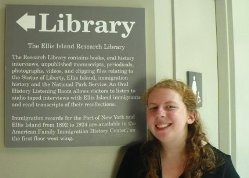 CONWAY, Ark. (Sept. 28, 2009) – Rachel Smith’s ancestors may have immigrated to the United States through Ellis Island. Then again, maybe not.
CONWAY, Ark. (Sept. 28, 2009) – Rachel Smith’s ancestors may have immigrated to the United States through Ellis Island. Then again, maybe not.
Smith, a history major, interned at the Ellis Island Immigration Museum in New York this past summer. She spent much of her time in the museum’s library, assisting the visitors in their search for their heritage. More than 12 million immigrants entered the U.S. through Ellis Island, and about 40 percent of Americans can trace their ancestry back to one of them.
Ironically, Smith knows nothing about her own family’s background.
“For as long as we can remember, we’ve been here,” she said. “I would love to do a genealogical search, but, you know, my last name is Smith.”
Although Smith, a junior, has no personal connection to the immigrant experience, she has long been fascinated by the late 1800s and early 1900s, the period when Ellis Island was busiest. One of her favorite tasks as an intern was to listen to immigrants describe that era in their own words.
Smith was responsible for transcribing the interviews conducted by the museum’s oral historian, who travels the country interviewing former Ellis Island immigrants. The historian spends about an hour asking about each person’s life history – why he or she came to the United States, what the transition period was like, whether he or she found the “American Dream”.
During Smith’s 10-week internship she transcribed three interviews.
“I wish I could have listened to more, but it was hard work,” she said. “The people being interviewed are mostly immigrants, so they have accents. And they’re old, so their voices are weak. Sometimes they an old married couple would do the interview together, so they’d be interrupting and talking over each other. It was very interesting, but also sometimes very frustrating.”
Smith also worked in the museum’s archives, a job she was surprised to find she enjoyed.
“Before my internship I was pretty anti-archive, because I thought it was boring,” she said. “It turned out I felt pretty at home in the library, putting away files, rather than being in the museum which was crazy with tourists and school groups. I like the backstage, behind-the-scenes aspects.”
The internship was unpaid, but it offered two perks: a free Metro pass and a pass to all the museums in New York City. The best reward, though, was the insight it gave her into her career goals. Smith wants to put her history degree to use in museum services.
“The internship reaffirmed how much I want the public to know about history,” she said. “Besides the classroom, it’s the best way to teach people about their history. It’s such an accessible way to learn, hearing, ‘This is the bench your family sat on while they were waiting for their immigration forms to be processed.’”
Smith received Odyssey funding to support her project. The grant provided a stipend, which covered her plane ticket and her living expenses in New York.
“My parents thought I would go to New York and kind of get it out of my system,” said Smith, the daughter of Dennis and Karen Smith of Sherwood. “But I really think I could live there.”
"Your Hendrix Odyssey: Engaging in Active Learning” is a major component of the Hendrix curriculum. The philosophy is, “You learn more when you do more.” Each student is required to complete three Odyssey experiences selected from six categories: artistic creativity, global awareness, professional and leadership development, service to the world, undergraduate research, and special projects. Smith’s project will earn her credit for Professional Leadership and Development.
Hendrix, founded in 1876, is an undergraduate liberal arts college emphasizing experiential learning in a demanding yet supportive environment. The college is profiled in Loren Pope’s book Colleges That Change Lives. Hendrix has been affiliated with the United Methodist Church since 1884. For more information, visit www.hendrix.edu.